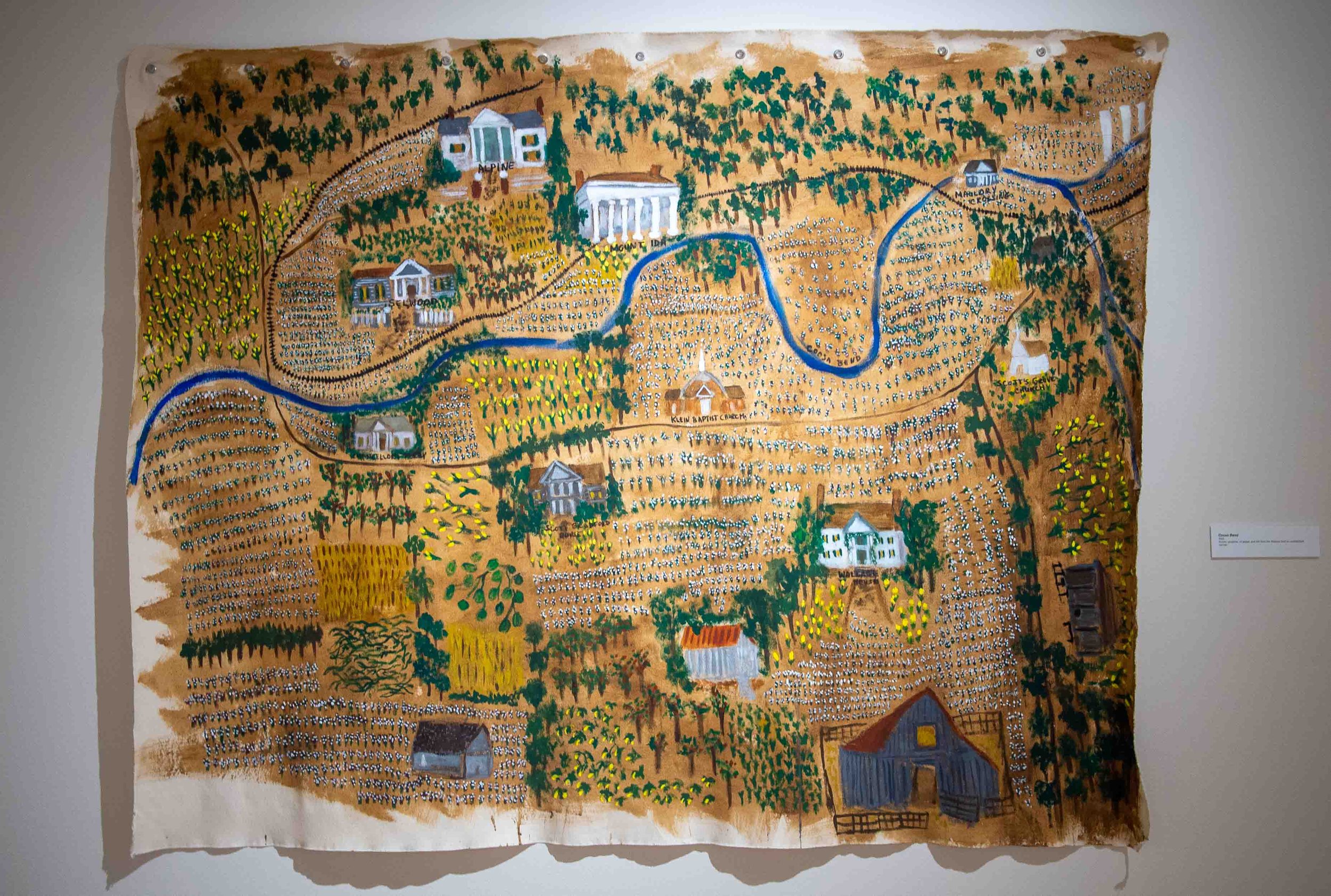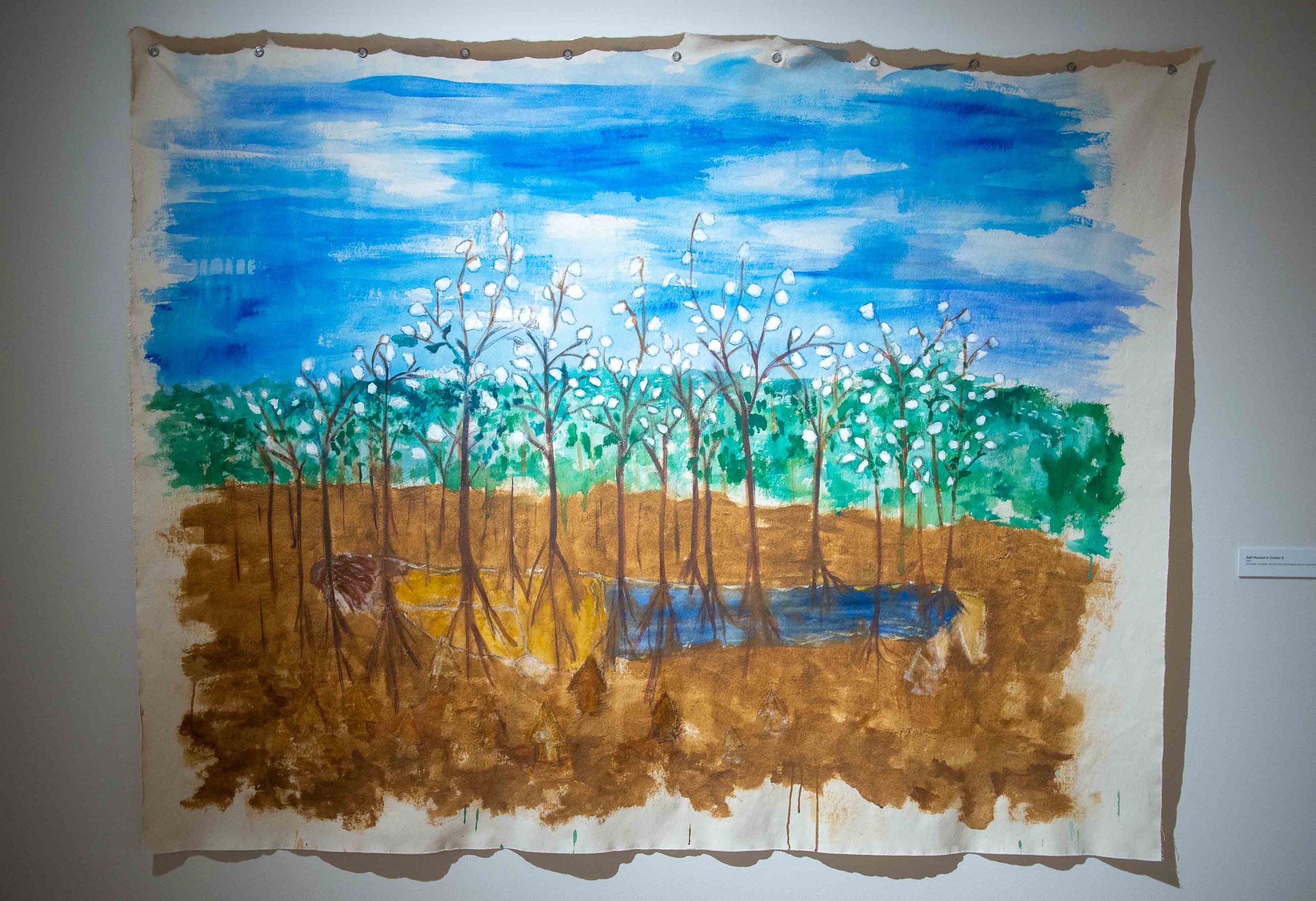Grounded Series
Three of five large unstretched canvases that address the importance of and complex relationships of my family and myself to cotton are included in Walk Humbly.. They use dirt from the plantation grounds as pigment, referencing Alabama artist Jimmy Lee Sudduth’s work. His work documented the African American culture of his rural community, and I was inspired to anchor my own memories and reflections of my white Southern roots in its earth pigment.
Coosa Bend. 48” x 76”. Gouache, oil pastel and dirt. Photograph of the 2022 installation of the exhibition at the Montgomery Museum of Fine Arts, Montgomery, Alabama.
Coosa Bend
Coosa Bend was inspired by the 2019 exhibit Mapping Memory: Space and History in 16th Century Mexico at the Blanton Museum in Austin. These Mapas de las Relaciones Geográficas were created by indigenous artists in the late 16th century for Spain and incorporate an amalgamation of imagery and symbols from their culture and from the colonizers . It is from the perspective of the Wallace House and outbuildings, looking to the Scott-Bradford House on the left and across and along the Coosa River to Selwood, Alpine, Mount Ida, and Mallory Crossing. Residents of the latter and the Wallace House stitched squares on the Mt. Ida Quilt made for the wedding of Virginia, the daughter of James Mallory, author of Walk Humbly, who resided at Selwood. The quilt is assumed to have been made at Mount Ida, home of the groom’s sister.
The resulting 4 x 6’ canvas reflects the mapmaking tradition of Mapas, representing a history and interpretation of the space occupied by these settlers from Virginia who became kith and kin. The brown pigment is dirt from the Wallace grounds. Cotton forms a sea around the buildings, crossing the highways, just as I saw it in 2018.
Self Portrait in Cotton 2, 2022. 48” x 76”. Gouache, oil pastel, and plantationdirt. Photograph of the 2022 installation of the exhibition at the Montgomery Museum of Fine Arts, Montgomery, Alabama.
Who am I to Wail?, 2020-22, 48”x76”, Gouache, oil pastel, plantation dirt and Sylacauga marble dust. Photograph of the 2022 installation of the exhibition at the Montgomery Museum of Fine Arts, Montgomery, Alabama.
Self Portrait in Cotton 2
Self-portrait in Cotton 2 continues my examination of my own life in relationship to cotton. My earlier Self Portrait in Cotton 1 showed my figure placed on top of a cotton field, being held up by cotton, on a funeral pyre, or lying on the shoulders of the people enslaved by my family who worked the fields. In this painting, my figure is buried face down in the earth under the cotton with roots surrounding my body and growing from it. At the last moment I added arrowheads facing up, as I face the fact that my ancestor came to Alabama to fight in the Creek Wars and these fields were once Muskogee Creek lands. Similar in size to Coosa Bend it also includes dirt from both Klein and the cotton field as the earth.
Who am I to Wail?
Who am I to Wail was originally made for Choked on Cotton as a second self-portrait in cotton, reflecting my feelings about the heritage of our family as enslavers. The lettering “Who am I? Who am I to wail?” was added after the choking of George Floyd in 2020. This happened as Choked on Cotton opened, and I could hardly look at the painting showing my own distress and its privileged position. Indeed, the exhibit title stuck in my throat. This pushed me to further exploration of my own identity in relationship to the past and present.


